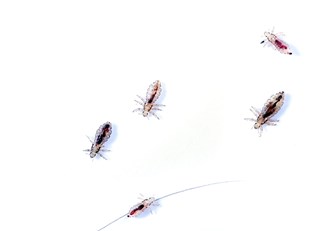If you experience itching in your genital area or see tiny insects lurking around your pubic hairs, it's very likely you have become infected with pubic lice, which are more commonly known as crabs. Pubic lice infestation, caused by sexual contact with an infected individual or sharing towels, bedding or other materials with an infected person. There are several ways you can obtain a diagnosis of pubic lice.
Scheduling an Examination
If you suspect that you are suffering from pubic lice, you can be examined at a local sexual health clinic. Many of these clinics are associated with local hospitals. You can also schedule an appointment with your own family doctor or general practitioner who can determine whether pubic lice are the source of your symptoms
Undergoing an Examination
During an examination for pubic lice, a medical professional will likely use a magnifying device to look for tiny lice, which are yellow-grey or dark red in color. Other evidence includes brown lice eggs attached to genital hair shafts or very tiny, white eggshells known as nits. If only nits are seen during an examination and no live pubic lice, it's possible that your infection is no longer active. It's wise to accept a prescribed medical treatment to kill any remaining lice or eggs that may still be present yet undetected.
Receiving Treatment
Once you have been diagnosed with pubic lice, your doctor or clinic can prescribe medical treatment. This usually involves using a shampoo containing active ingredients that will kill both lice and remaining eggs in the affected area. If you already know you have pubic lice without receiving an official diagnosis, there are several over-the-counter medications containing permethrin available in lotion or mousse form. Usually just a five-minute treatment does the job of killing any active lice infestation, but care must be taken to remove any lingering eggs or nits using a very fine-tooth comb.
Preventing Re-infestation
After receiving a diagnosis of pubic lice, it's important to inform any people with whom you have had sexual contact within the past 30 days so that they can get checked as well. All of your bedding, towels, and clothing should be washed in extremely hot water, then dried in the clothes dryer at a hot setting. If an item cannot be laundered or dry cleaned, apply a special medicated spray and then seal the items in plastic bags over a two-week period to suffocate the lice.
Be careful not to itch or scratch the infected area after treatment to avoid infection. Return to the clinic or contact your family doctor if the prescribed medication doesn't work and you still see evidence of insects or eggs in your pubic region.



